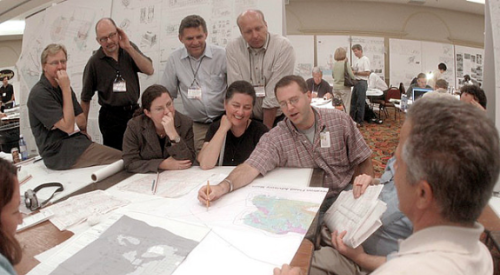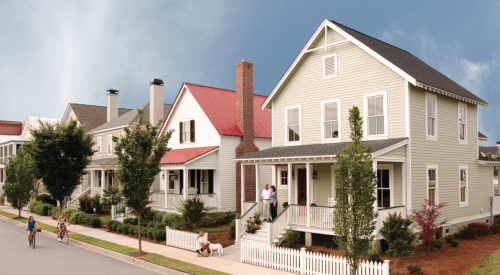| Historic Old Sandwich Road, top, has not changed in more than 300 years. It will be preserved as part of the master plan for The Pinehills, Plymouth, Mass. At bottom, a bird’s-eye view looking northeast from the visitor center, Summerhouse. When built out, two-thirds of the 3000-acre site will be open space.
|
Except for two cranberry bogs, a nearby pond known for its trout fishing 140 years ago, a small rye field adjacent to a tavern built in 1792 and a 1928 homestead, the only real development on this 3000-acre parcel in Plymouth, Mass., is a dirt road laid out by the king in 1652. The land, seven miles from Plymouth Rock and 45 miles south of Boston, remained undeveloped first as a result of its dry and steep natural topography and later because two successive families preserved the land as their own until Digital Equipment Corp. bought it in the early 80s as a site for its corporate campus.
Shaped roughly like a football set in a north-south orientation about a mile from the coast, the east side of the five-square-mile property rises on a large sandy moraine to heights of almost 400 feet. There, amidst the pitch pines and scrub oak on its plateau-like summits, are views across Cape Cod Bay to the horizon and a slender, hooking line of land that is the entirety of the Cape itself. Geologically speaking, the western two-thirds of the property is equally compelling. It consists of ridges, hills and dramatic tiny valleys called kettles.
After Digital’s plans for the property changed during the economic downturn of 1991, a new chapter in the area’s history was written. It is a story of how an unusual development team utilized the different skills of a local real estate investor, a commercial developer and a home building company to form a partnership among themselves, and in a sense, with the larger community of Plymouth. The result is a forward looking, environmentally sensitive, mixed-use master plan that is a model of smart growth.
When completed, The Pinehills master plan will consist of three major elements:
For neighboring Plymouth, The Pinehills meets several community objectives. The Marriott’s, 250-room regional conference center courts business travelers and tourists, who, for want of a place to stay, tend to visit for the day and leave. The $1 billion buildout also bolsters Plymouth’s tax base. Lastly and most importantly, the town will keep what it has always had: plenty of open space and a strong history.
Among the public benefits are areas set aside for open space preservation including 206 acres of reserved land near neighbors and a 350-acre nature preserve across the northern end of the property. Also untouched will be the cranberry bogs, the rye field and tavern, as well as a wide buffer on both sides of Old Sandwich Road, which will remain just as the Pilgrims left it - a scenic, 20-foot-wide, stretch of dirt and gravel bordered by towering pines.
Taking a Chance on a Long Shot
The unusual partnership had an impressive goal: to create a place to live, work and play that kept the feeling of small town New England. The eventual partners included: Steve Karp and Steve Fischman, principals of New England Development, the largest private developer in the Northeast; Tom and Walter Wallace of Wallace Associates, a local entrepreneur; and Alan, Dan and Tony Green, the current and former principals of The Green Companies.
Digital’s 3000 acres did not sell quickly for many of the reasons that developers typically shy away from unpermitted land:
Zoned Rural Residential, the property also was listed within a special forestry preserve section of state law. Digital received this designation in 1982, lowering its taxes to $25,000 annually. Any buyer would also be required to pay the difference, over $1 million in back taxes, in order to proceed with development. The alternative was even less attractive: grant the town the right of first refusal and hope it passed on the opportunity, and it pays the back taxes.
In April of 1994, Plymouth resident and real estate investor Tom Wallace offered to purchase the property from Digital for approximately $10 million. The contract, formalized six months later, had plenty of written contingencies. Evidenced by the fact that he and his future partners did not close on the deal until February 4, 1998. Wallace says it seemed like "the longest purchase-sale agreement in history."
At the outset, Wallace, along with his daughter Denise Spencer, a market research consultant, local attorney Bob Betters and engineering advisor Bob Daylor, faced a question that went beyond simply what to build and where. Initial plans detailed 1.5 million square feet of retail space near the highway interchange portion of the property and a subdivision of 250 homes. The question was what kind of zoning to seek for the parcel: use something already on the books or go for something new? At that point combining open space, residential and commercial in a single rezoning did not exist.
In the end, it took Wallace four Town Meeting votes - the first in April of 1995 and the last in April of 1996 - and almost $1 million to get a new type of zoning approved. Originally conceived by Spencer, Betters and Daylor, it was called Open Space Mixed Use Development (OSMUD). It was based on a familiar principle in Plymouth of allowing "floating zones" implemented by special permits requiring super majority votes from the town planning board. Within OSMUD as it was originally written, each land use was wholly separated by specified setbacks. With zoning in place, Wallace remembers being ready to seek the partnership of "real developers."
"We were at great personal risk," says Wallace. If we did not make something of it, we would have lost everything."
On a recommendation, he approached Steve Karp and Steve Fischman of New England Development and they, in turn, put Wallace in touch with The Green Companies. In a subsequent meeting at The Green Companies’ offices, Wallace says he quickly decided that he had found the right partner in Tony Green, who, in addition to having been successful as a home builder, holds undergraduate and graduate degrees in land planning from Harvard. What particularly impressed Wallace was that Green presented the benefits of the OSMUD zoning to his team with an entirely new vision for the project’s potential.
"He understood [OSMUD’s] potential in ways we didn’t and we helped write it," notes Wallace.
Green’s view is that traditional zoning imposes a false geometry on the land. While it may work adequately on flat parcels, it utterly ignores the benefits and constraints of hilly land.
"Most builders look for flat land,: explains Green. "We actually look for sloped land because it allows us to fit the home into the topography in a way that maximizes the view and minimizes the disturbance to the natural setting behind the house."
| Anchored by a Marriott hotel, a mixed-use, pedestrian oriented village is planned around this New England pitch.
|
"The principles that guided our choices at Pinehills really revolve around a very simple statement: That some land is appropriate for building and some land is not and knowing the difference is the key," says Green. "Any planning practices that allow choices based on the attributes of the land, its relationship to a particular marketplace and the goals of the larger community rather than relying on the strict geometry of traditional zoning is a good thing."
That first day, at the end of 1996, Green says he knew he had "a good thing" in the Open Space Mixed Use zoning of 3000 acres in Plymouth. As a trained land planner and through years of experience as a builder, he understood the unique qualities of the land itself.
Meeting the Land and the People
With the partnership in place in the spring of 1997, the group began managing the re-zoning and entitlement processes. Like most master plan approvals, it was a campaign conducted on a number of fronts. There was the paperwork and meeting schedules associated with a multi-governmental approval process. There were details of specific land use options to consider and finalize. And most importantly, there was the task of building consensus with officials and residents.
All of this was taken on with a raft of specialists and consultants. An interesting wrinkle for non-New Englanders is the provisions of the Town Meeting form of government. Granted that while more people do typically have a say under such a system, the basics are the same as everywhere else. In the old days, Town Meeting enfranchised all adults with the ability to vote. Then as now, a two-thirds majority is required for passage. Today 113 members, each representing about 450 residents, cast votes. In Plymouth, the body has regular meetings only twice a year.
All of this was important, because between June of 1997 and June of 2000 there were 151 formal meetings and hearings, not including all of the less formal gatherings and invitations to see what was planned out on the site. Green’s approach was to educate the town out on the land, demonstrating the view-orientated site selection process while walking in mown paths that "allow people to see the land from a different perspective," says Green.
The first days in Plymouth involved driving dirt access roads and walking the woods measuring the site for the breadth of views offered on all the various ridges, hills and kettles. To Green it was one of the key factors to be determined before deciding whether to go forward with The Pinehills partnership. If Green was correct in his analysis of the zoning, OSMUD (and the more sophisticated descendent that was later approved to allow for the full Pinehills master plan) would allow for clusters of homes to be built in these locations. These clusters could then be interspersed with permanently protected areas of open space for view-shed. In all, land planners at Sasaki Associates calculated more than 170,000 lineal feet of view that, when combined with some of the magnificent vistas of Cape Cod, added up to a lot of premium views.
| Ten segments of empty nester buyers are seen as buyers. The Green Co.’s opened these first models in October.
|
To test its assumptions, The Pinehills held a series of focus groups and workshops - at first with "blind" age and income-qualified people in a formal behind-the-glass setting with professional moderators, then with "volunteers" from among those who called trying to find out more about the land, which were run in-house at a local bed and breakfast. Nearly 700 people participated in workshops, which provided learning opportunities on both sides.
"We took the approach that all of these people were going to be our customers so why don’t we find out what they want," says Green. "We asked questions about how they live and from their answers we determined that we had an opportunity."
In June of 1997, The Pinehills LLC development team informally introduced themselves to local officials, town planners, and concerned citizens at a meeting they held at the Plymouth Yacht Club. There, they sought to both assuage some fears as well as generate enthusiasm for a new project that on paper looked much like the one now being built.
Local officials and members of the community, looking back at the event, say the tone set that evening was one of professionalism and candor. That meeting and subsequent communications turned skeptics into supporters.
| Understated signage welcomes home buyers to Stone’s Throw, Pinehills’ first custom home community.
|
Walking tours on site enabled Green and Pinehill’s project manager John Judge to meet with small groups and "demonstrate the Pinehills approach." As the workshops addressed the environmental character of the land from soils to wetlands, as well as the built environment from home siting to the town center, trust began to develop. Workshops were not required, but they were a public discussion used to form a basis of comparison to a variety of "futures" for the land, says Green.
The first special permits cobbled together three floating zones in a single master plan that was approved then appealed in the spring of 1998. The planning board and the Board of Selectmen encouraged negotiation and the appellants, the town and The Pinehills provided a unified front, jointly supporting compromise zoning. It reduced the amount of commercial to 1.3 million square feet from 2.4 million and added entitlements for 900 more homes.
With a new master plan under revised zoning, construction began in the spring of 1999. Ground was broken on the visitor center, Summerhouse, and for the first roads. One state permit for groundwater discharge remained. The final permit, not issued until March 2000, was a performance based permit, which required the use of sensitive receptors at the property border to measure the down gradient.
That permit and the special permit for the hotel were both appealed in the spring of 2000 and all the time and effort invested in touring and workshops, coupled with the very convincing presence of the newly occupied Summerhouse, convinced the Town Meeting to approve the master plan and OSMUD as of right. Final compromises initiated by the Department of Environmental Protection settled the wastewater appeal.
Each round of appeal and revision kept the essence of open space, mixed-use development intact, and built upon the foundation of dialogue begun three and a half years prior.
According to Filla, the planning and approval process at Pinehills raised the bar for future developers. "Other developers now know that the process involves showing what the land can do, showing what the capability of the land is."
Also See:
Elements of a Successful Entitlement Campaign












